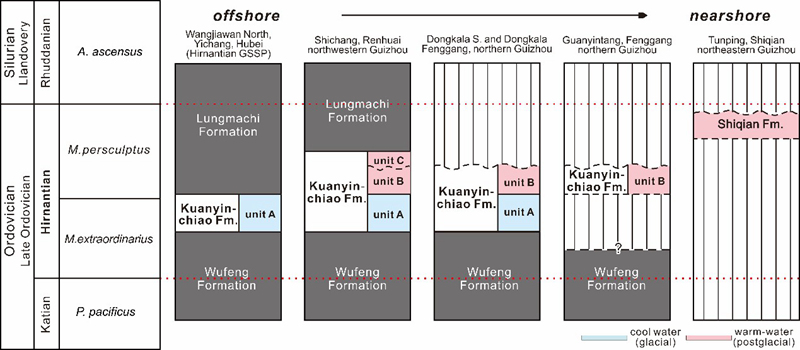
Revised stratigraphic framework of Hirnantian shelly rocks on the Upper Yangtze Platform of South China, indicating the interpreted association of these strata with Hirnantian glaciation
Considerable uncertainties over many aspects of process and mechanism of end-Ordovician extinction still remain. One of the major difficulties is the problematic stratigraphic correlation of Hirnantian rocks between South China, where the Hirnantian GSSP is situated, and shallow water carbonate platforms in low latitudes. In South China, black graptolitic shales are well developed, and shelly strata have been widely considered as being represented only by the early to mid-Hirnantian Kuanyinchiao Formation (and its stratigraphic equivalents) deposited during the major Hirnantian glaciation. In shallow-water carbonate platforms from low-latitude regions, for example, Laurentia and Baltica, shelly fossils are dominant, and graptolites are either absent or very rare.
Recently, Dr. WANG Guangxu from Nanjing Institute of Geology and Palaeontology, Chinese Academy of Sciences and his colleagues further reveals the temporal and spatial distribution of Hirnantian near-shore carbonates and shelly fossils in many areas of northern Guizhou, South China, which allows a critical stratigraphic revision and hence the establishment of a robust regional stratigraphic correlation.
The Kuanyinchiao formation is revised to include three informal subdivisions, that is, units A, B, and C, in ascending order. Unit B of the formation typically is dominated by peloidal or oolitic grainstones, and unit C is composed of skeletal wackestone and calcareous mudstone, both units sharing distinctive coral and brachiopod faunas. This contrasts sharply with unit A of the formation, consisting of mudstone, silty mudstone, or calcareous mudstone, that yields the cool-water Hirnantia fauna and associated coral fauna. In view of the presence of carbonate ooids and peloids, rugose corals, and a distinctive brachiopod assemblage, all indicative of warm-water conditions, unit B, as well as unit C yielding the same shelly fauna, is interpreted as representing postglacial sedimentation immediately following the major Hirnantian glaciation, thus marking a significant climatic shift.
More importantly, new findings indicate that biotic recovery after end-Ordovician extinction and its associated Hirnantian deglaciation probably have started from middle Hiranntian.
Download:
